You won’t believe what these world-famous landmarks looked like 100 years ago
Incredible attractions and how they’ve changed

YUICHI YAMAZAKI/AFP via Getty Images/Fox Photos/Getty Images
The Roaring Twenties saw a booming global economy, an optimistic post-First World War atmosphere and the development of commercial air travel – all of which combined to spark a significant increase in both domestic and international holidays, allowing many to visit and appreciate some of the world’s most famous landmarks up close for the very first time.
Read on to discover how they looked around 100 years ago, compared to today...
Arc de Triomphe, Paris, France

Fox Photos/Getty Images
With its ornate, Neoclassical and towering 164-foot (50m) frame, it’s hard not to be impressed by the Arc de Triomphe. It’s not surprising, then, that the lavish landmark took a whopping 30 years to build. Commissioned by Napoleon I in 1806, the arch stands at the centre of the aptly-named Place de l’Etoile, or Star Square, whose streets radiate outwards in a star-like formation. Pictured here in 1929, it’s surrounded by electric street lights – Paris was the first city in the world to introduce this innovation in 1878.
Arc de Triomphe, Paris, France

Matthew Dixon/Shutterstock
Along with the stunning sculptures that adorn the outside, each depicting a military victory, the insides of the pillars bear the names of French generals who died in battle. Ever since its completion in 1836, the arch has been the site of many important marches, as well as serving as the starting point of the Bastille Day Military Parade and the endpoint of the Tour de France. Today, visitors who climb the 280 stairs to the top will be rewarded with stunning panoramic views across Paris.
Hollywood sign, Los Angeles, California, USA

Michael Ochs Archives/Getty Images
Arguably even more well-known than the place itself, the Hollywood sign was erected in 1923 – but it once read 'Hollywoodland'. In the 1920s, Hollywood was beginning to be recognised as a hub for the movie industry, so real estate developer Harry Chandler built the sign to advertise his new, upmarket housing development. It’s shown here in 1925 with a group of surveyors posing beneath it. The sign was only supposed to last a year and a half, but it has stood for almost a century.
Hollywood sign, Los Angeles, California, USA

rus p/Shutterstock
So when did it lose those last four letters? During the Great Depression in the 1930s, the Hollywoodland housing development went bankrupt and maintenance of the sign fell to the wayside. When the sign came under city ownership in the mid-1940s, it was almost razed, but the Hollywood Chamber of Commerce decided to axe the 'land' part instead. It was then completely replaced in the 1970s, funded by Playboy mogul Hugh Hefner and other celebrity donors. Seen here from LA, the sign is now synonymous with Tinseltown.
Times Square, New York City, New York, USA

Bettmann/Getty Images
As recently as the 1880s, Times Square (then known as Longacre Square) was a fairly empty space with a smattering of apartments. But that all changed in 1904, when The New York Times built a huge tower here for its new headquarters and the area was renamed Times Square. In the 1920s, West 42nd Street became a stop-off point for new subway lines and bus routes, cementing the square’s position as the hub of the city.
Times Square, New York City, New York, USA

valeriy eydlin/Shutterstock
The area’s reputation dwindled in the 1960s and 1970s, as it began to be associated with crime and adult entertainment – in fact, by the late 1970s, it was receiving the most crime complaints in all of the city. Plenty of money and resources were ploughed into redevelopment projects from the 1980s onwards. Today, Times Square is known for its splashy billboards and neon lights, and while it might be preferred by snap-happy tourists to locals, it remains one of New York City's most recognisable attractions.
Eiffel Tower, Paris, France

Bettmann/Getty Images
The Eiffel Tower has become synonymous with Paris. So you might be surprised to learn that when the design was first revealed, many people thought it was ugly. To mark the city’s International Exposition of 1889, a competition was held to design a new monument and the winning idea, created by French engineer Gustave Eiffel, was selected out of more than 100 entries. However, many locals thought the building would clash with Paris’ aesthetic and wrote a letter railing against its construction.
Eiffel Tower, Paris, France

Valery Egorov/Shutterstock
Despite the backlash, building works went ahead and the Eiffel Tower was completed on 31 March 1889. Although it was only meant to last 20 years, it began to be used as a radio antenna for communications in the late 1890s, and city officials allowed it to stay. It’s a good thing they did: nowadays, the landmark is typically visited by around seven million visitors a year and it’s one of the most popular attractions in France.
Taj Mahal, Agra, India

The Print Collector/Getty Images
Shown here in 1924, the beautifully symmetrical Taj Mahal is easily India’s most famous landmark. It was built between 1631 and 1648 by emperor Shah Jahan, who wanted to create a monument to his wife, Mumtaz Mahal, who had died in childbirth. Constructed from dazzling white marble, which transforms in colour depending on the time of day, it’s considered one of the world’s finest examples of Mughal architecture – a mix of Persian, Indian and Islamic design styles.
Taj Mahal, Agra, India

AlexAnton/Shutterstock
As perfectly preserved as it may seem, the Taj Mahal hasn’t been immune to damage over the years. In the late 19th century, following significant neglect and decay, a massive restoration project took place under the order of Lord Curzon, the British viceroy of India. Today, concerns have shifted towards air pollution emitted by nearby factories and cars, which threaten to taint its shining marble facade. The landmark is so popular there are now caps on visitor numbers – limited to 40,000 people per day.
Colosseum, Rome, Italy

Italian Government/PhotoQuest/Getty Images
Visitors over the centuries have been wowed by Rome’s Colosseum, and it’s easy to see why. So it’s all the more astounding that this 620 by 513 feet (199x150m) amphitheatre was built more than 2,000 years ago. Construction began around AD 70 and 72 and lasted for about a decade – the finished amphitheatre had space for 50,000 people. However, it has suffered significant decay: by the 20th century, around two-thirds of the original building had been lost due to neglect and damage by several earthquakes.
Colosseum, Rome, Italy

Stefano Tammaro/Shutterstock
The Colosseum we see today is a result of extensive restoration in the 1990s. While it may no longer host gladiator fights, the amphitheatre puts on regular exhibitions about ancient Roman culture, which are shown to its roughly five million annual visitors. In May 2021, the Italian government unveiled their plans for another restoration project, which will include a new, retractable floor in the centre of the arena, so that visitors can share the same view that gladiators had in Roman times. Work was due to be completed in 2023, but no update has yet been given.
Great Sphinx of Giza, Egypt
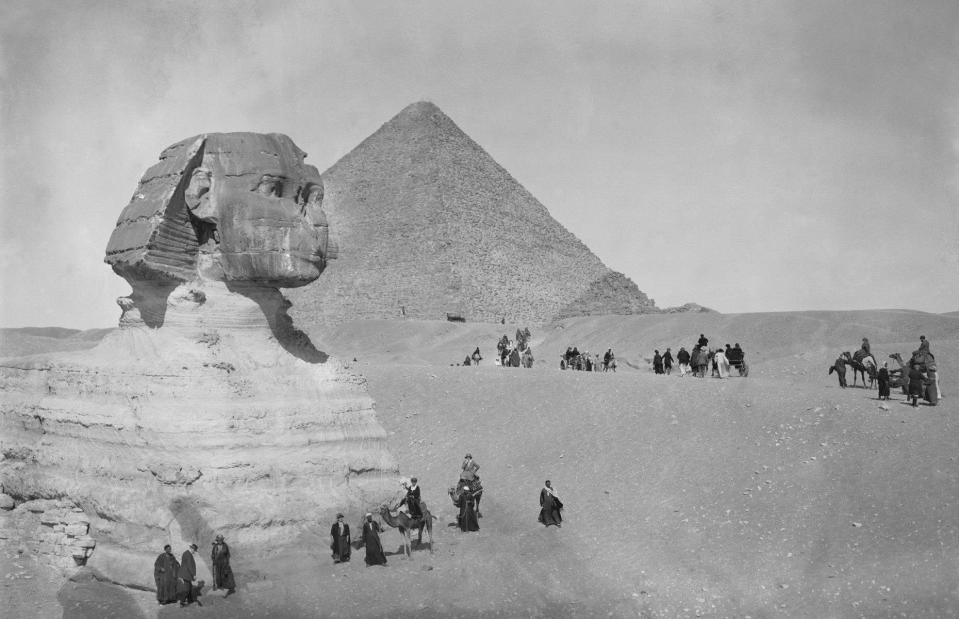
Topical Press Agency/Hulton Archive/Getty Images
Cruise travel was booming in the 1920s, allowing the world’s wealthy elite to access far-flung destinations for the first time. And Egypt, with its many ancient attractions, quickly became popular. Pictured here, a group of American tourists pose with the Great Sphinx of Giza in 1923. This enormous limestone sculpture, measuring 66 feet (20m) tall and 240 feet (73m) long, was built some 4,500 years ago during the reign of Pharaoh Khafre.
Great Sphinx of Giza, Egypt

Daily Travel Photos/Shutterstock
The giant statue, located in the Giza Plateau near the Great Pyramid, was modelled on the mythological creature of a sphinx – a human head on a lion’s body. It wasn’t until the early 19th century that the body was revealed, though, when a Genoese explorer and a team of around 160 men attempted to dig it out. Although their attempts failed, the sphinx was completely excavated by the late 1930s. If you look closely, you’ll see that in the previous photograph, its feet are not visible.
Brandenburg Gate, Berlin, Germany

Hulton Archive/Getty Images
Overlooking charming Pariser Platz, Berlin’s Brandenburg Gate is steeped in history. Built between 1788 and 1791 and designed to be an entry point into the city, the Neoclassical gateway was topped with a statue known as the 'Quadriga' shortly afterwards. Yet the chariot-and-horses statue was stolen by Napoleon Bonaparte in 1806 and only returned after his forced abdication eight years later. Pictured here in 1928, a Graf Zeppelin, the world’s most successful airship, flies over the gate.
Brandenburg Gate, Berlin, Germany

rebaix-fotografie/Shutterstock
One of the few significant landmarks in Berlin to survive the Second World War, the gate has come to symbolise the division between the East and West – and subsequent unity. In 1961, when the Berlin Wall went up, the gateway was enclosed in an exclusion zone meaning people couldn’t see it. Since Berlin was reunified in 1989, it’s become one of the city’s most popular attractions.
Stonehenge, Salisbury, England, UK
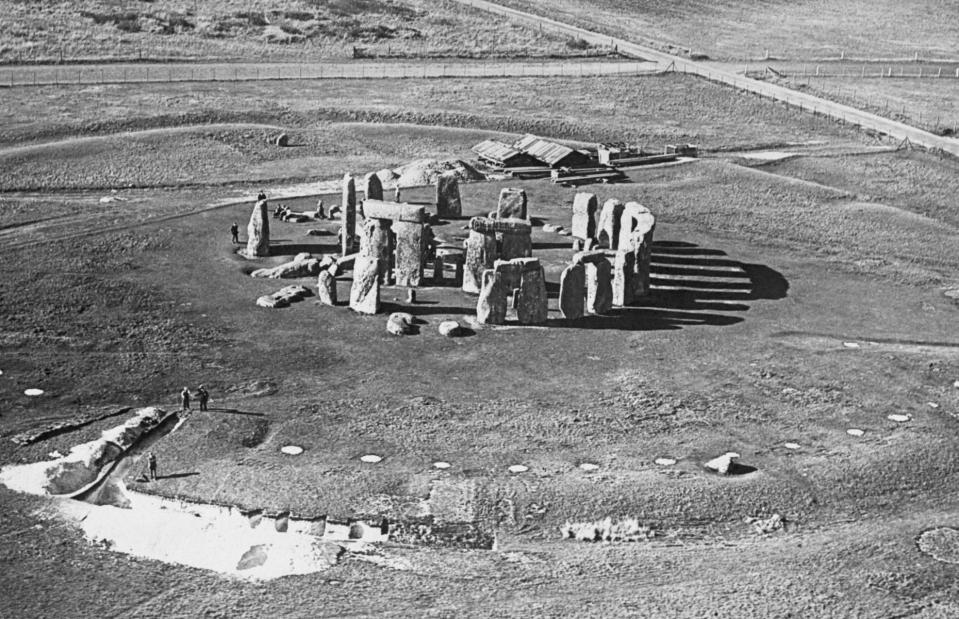
Bettmann/Getty
A century is practically the blink of an eye in Stonehenge’s 5,000-year existence. One of the most famous prehistoric monuments in the world, the awe-inspiring stone circle was built in six stages, from around 3000 BC to 1520 BC. It was made from two types of stone: larger sarsen stones and smaller bluestones. Incredibly, the bluestones are thought to have been transported all the way from Wales’ Preseli Hills, around 200 miles (322km) away, despite weighing between two and five tonnes each. Stonehenge became a popular attraction in Victorian times, but uncontrolled tourism led to vandalism, so an entry fee was introduced in 1901.
Stonehenge, Salisbury, England, UK

Drone Explorer/Shutterstock
Stonehenge itself hasn’t changed much in the last century, but it’s certainly seen some things. In 1985, a convoy of 600 travellers headed to the site for the Stonehenge Free Festival, only to be met by more than 1,000 police officers. The ensuing clash, known as the Battle of Beanfield, lasted several hours and resulted in 537 arrests. Since 2013, Stonehenge has benefitted from a shiny new visitor centre which includes a 360-degree interactive virtual experience, as well as prehistoric artefacts found at the site. In recent years, a fence has also been added, so visitors can’t go right up to the ancient stone structure.
Chichen Itza, Yucatan, Mexico

Bettmann/Getty Images
Mexico’s stunning Yucatan Peninsula is packed full of Mayan archaeological sites and Chichen Itza is easily the most impressive. Covering a four-square-mile (10sq km) patch of arid land, the city was founded around the sixth century AD and it quickly became an economic and political hub, housing some 35,000 people at its peak. Sometime in the 15th century it was abandoned and left to deteriorate until excavations began in the 1900s. Pictured here is a tourist at the Casa de las Monjas monastery in 1923.
Chichen Itza, Yucatan, Mexico

RODRIGO ARANGUA/AFP via Getty Images
The Pre-Hispanic city has a number of impressive monuments: the pyramid-shaped El Castillo; the Temple of the Warriors; and the Ball Court, an ancient sports arena. And archaeologists are still making more discoveries today. In 2016, researchers found a smaller pyramid inside El Castillo using imaging technology, cementing the idea that the pyramid was built in a nesting doll formation. The popular site typically draws in around two million visitors annually.
Duomo, Milan, Italy

Smith Collection/Gado/Getty Images
The impressive Duomo in Milan took six centuries, countless rulers and thousands of workers to complete. In fact, the process was so long it turned into a popular idiom for a never-ending task: “lungh me la fabrica del Domm”, which means “long as the work on the Duomo” in Milanese. Started in 1386 by Milan’s ruler Giangaleazzo Visconti, the project was abandoned in 1418. In the 16th century, further works were completed under Archbishop Borromeo, while the facade was finished under Napoleon in the 19th century. Pictured here in 1922, it still wasn’t quite done!
Duomo, Milan, Italy
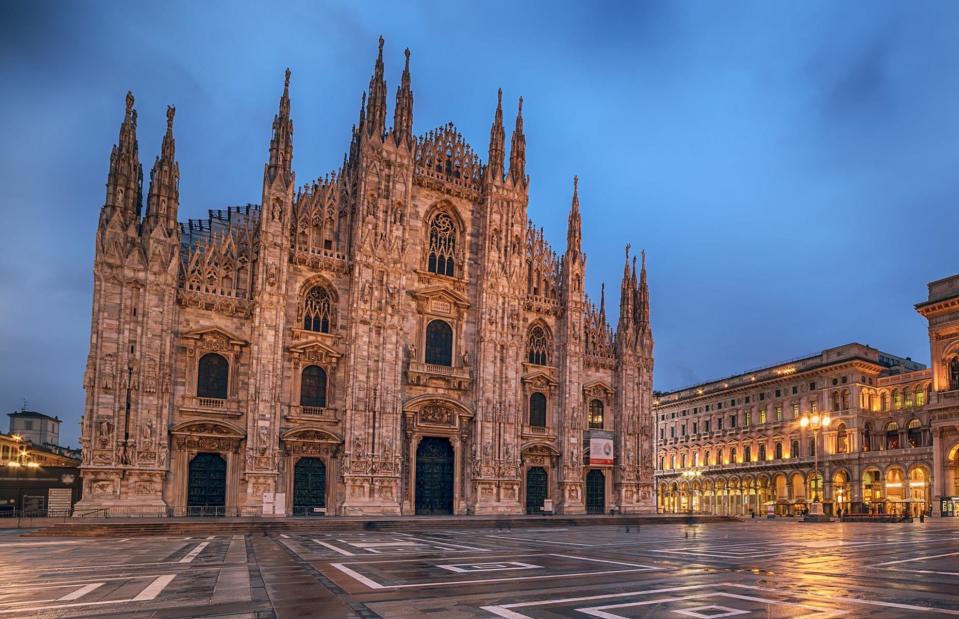
krivinis/Shutterstock
The finishing touches, including the fitting of doors and Neo-Gothic ornaments, were added between 1909 and 1965. Today, it’s hard not to be wowed by the imposing building. Some six million visitors each year come to feast their eyes on the Duomo, with its intricate statues, gargoyles and spires brought to life in shimmering pink-hued marble.
Tower Bridge, London, England, UK

The Montifraulo Collection/Getty Images
Little more than two decades old when this picture was taken, Tower Bridge was completed in 1894. The 200-foot (61m) high, 800-foot (240m) long bridge was the largest and most complex bascule bridge of its time – a type of bridge with two split sections which can be raised to allow boats to pass through. The bascules were originally powered by steam and took just a minute to rise fully, although they’re now rarely used.
Tower Bridge, London, England, UK

Pocholo Calapre/Shutterstock
Its unique construction has proven to be both a blessing and a curse. In 1952, Albert Gunter was driving the number 78 bus across the bridge when the sections began to lift, and he had to accelerate quickly to jump across the bascule. Miraculously, out of all 20 passengers on board, the worst injury was a broken leg. In more recent history, it featured in the London 2012 Olympics opening ceremony, in which a stunt double of the late Queen Elizabeth II was carried by helicopter through the bridge.
Acropolis, Athens, Greece

Swarbrick/Hulton Archive/Getty Images
Meaning 'high city' in Greek, this aptly-named settlement sits on a steep hill towering above Athens. The earliest beginnings of the city we see today date back to the 13th century BC, when a fortification wall was built around the home of the Mycenaean ruler of the time. Around Athen’s Golden Age in the 5th century BC, its best-known landmarks, including the Propylaea gateway and the Parthenon and Erechtheion temples, were built. The site became popular as a tourist destination in the early 20th century and is pictured here in 1925.
Acropolis, Athens, Greece
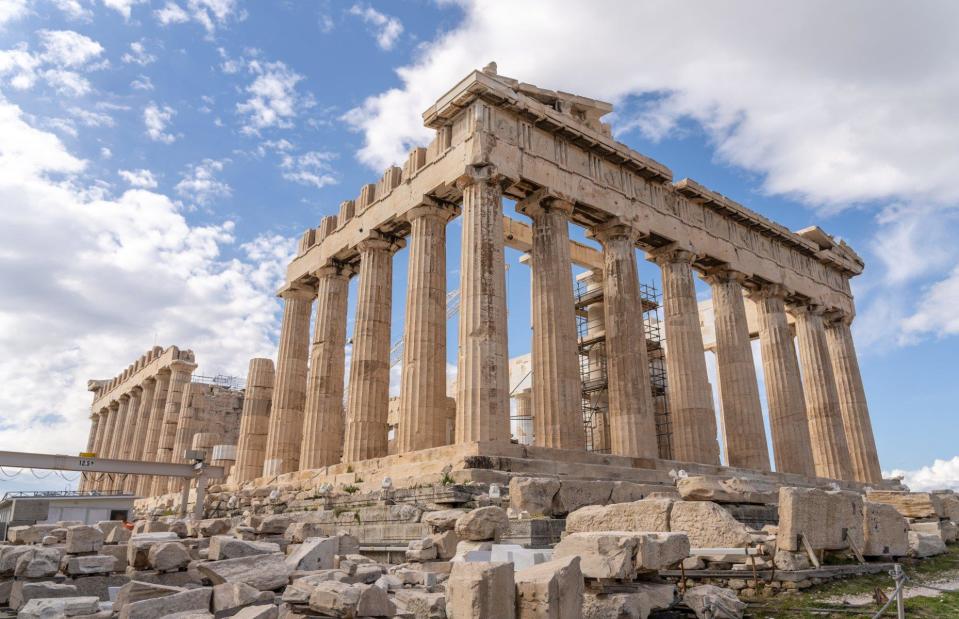
Miruna Ioana/Shutterstock
But its long history hasn’t been without controversy. In 1803, a British nobleman, the Earl of Elgin, shipped many of the Acropolis’ ancient sculptures to England and sold them to the British Museum, where they remain today. Although Elgin was given the green light by the occupying Turkish government at the time, successive Greek governments since 1832 have ordered that the artefacts be returned – and the scandal is still making headlines in 2024. Nevertheless, the Acropolis is one of the most popular attractions in Greece, to the extent that visitor numbers are now capped at 20,000 per day.
Statue of Liberty, New York City, New York, USA

Underwood Archives/Getty Images
Pictured here being greeted by a group of sailors in 1920, Lady Liberty was gifted to America by France in the late 19th century. The brainchild of French sculptor Frederic-Auguste Bartholdi, the towering 305-feet (93m) high statue on Liberty Island was built from hammered copper. She owes her distinctive green hue to sunlight and rain, which has caused the once-shiny copper to oxidise.
Statue of Liberty, New York City, New York, USA

Matej Hudovernik/Shutterstock
Few New York attractions match the Statue of Liberty’s storied appeal today. Some four million visitors come to see the statue each year, and a museum on Liberty Island opened in 2019, allows tourists to take a deeper dive into the history of the emblematic monument. It’s also possible to climb to the top of the statue’s crown.
Houses of Parliament, London, England, UK

Print Collector/Getty Images
Standing on the banks of the River Thames, the Houses of Parliament were built between 1837 and 1860. Yet the building’s legacy goes back much further than that. A royal palace has existed on this spot since the 11th century, where it remained until it was ravaged by fire in 1512. Renowned architect Sir Charles Barry is responsible for the Gothic-Revival design, which includes 1,100 rooms spread across an eight-acre site.
Houses of Parliament, London, England, UK

Alexey Fedorenko/Shutterstock
The Westminster landmark has borne witness to a number of important historical events since then – and survived more than a few scrapes. It was severely damaged by a bomb in 1885, as well as being hit around 14 times during the Second World War and targeted by the IRA in 1974. Today, as well as attracting throngs of tourists, protesters often target the Houses of Parliament, meaning it’s never far from the headlines.
Washington Monument, Washington DC, USA

Bettmann/Getty Images
Dedicated to the first president of the United States, this cloud-piercing granite and Maryland marble obelisk has stood in its completed state for almost 140 years. Four decades after its cornerstone was first laid, the Washington Monument opened to the public in 1888. Seen here in 1922, it sits at the centre of a near-perfect square of DC landmarks, comprising the White House to the north, the US Capitol to the east, the Thomas Jefferson Memorial to the south and the Lincoln Memorial to the west.
Washington Monument, Washington DC, USA

Sean Pavone/Shutterstock
The Washington Monument underwent its first major restoration in the 1930s, followed by further works in the 1960s, 90s and 2010s. In 2011, a 5.8-magnitude earthquake inflicted significant damage on the monument, cracking the marble in over 150 different places and leading to a three-year closure. Today, it sees more than 800,000 annual visitors and remains the tallest stone structure in the world.
Giant’s Causeway, Co. Antrim, Northern Ireland, UK

Antiqua Print Gallery/Alamy
Made up of around 40,000 hexagonal basalt columns on the shores of County Antrim, the Giant's Causeway is the work of the Irish giant Finn MacCool, if you believe the local legend. However, scientists have dated these unusual rock formations back 50 to 60 million years, when lava flowed into the sea, cooling and cracking as it met the cold water.
Giant’s Causeway, Co. Antrim, Northern Ireland, UK

iLongLoveKing/Shutterstock
This otherworldly coastline was first unveiled to the wider world in 1693 and later became a favourite destination among well-heeled Victorians, who would ride on the then-cutting-edge railway which still operates out of Bushmills. The Giant’s Causeway has been a National Trust property since 1961 and was thereafter extended to cover an extra 200 acres before being designated by UNESCO in 1986. A modern, grass-roofed visitor centre was added in 2012 after the previous one burnt down; some 400,000 tourists now make the pilgrimage here each year.
Niagara Falls, Ontario, Canada
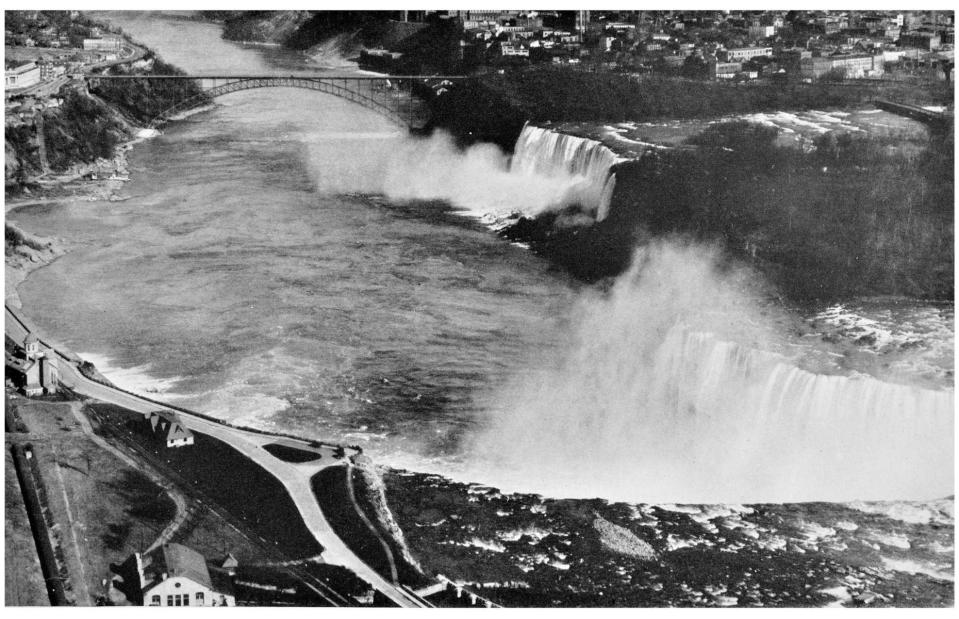
SOTK2011/Alamy
Collectively, Horseshoe Falls, American Falls and Bridal Veil Falls make up the largest waterfall by volume in North America. Straddling the US-Canada border, Niagara Falls now lends its name to a city and district that owe their prosperity to the popularity of this super-sized cascade. It has been a tourist attraction for around 200 years, ever since the Erie Canal was completed in 1825, making the falls accessible to all (not just the wealthy) for the first time. The Niagara Reservation was established in 1883 as the first state park, with this picture taken a century ago in 1924.
Niagara Falls, Ontario, Canada

Shawn.ccf/Shutterstock
Niagara Falls has historically been dubbed the ‘Honeymoon Capital of the World’, inspiring high-profile weddings, hit songs and Hollywood movies throughout the 19th and 20th centuries. Later, it became a breeding ground of cutthroat commercialisation and daredevil publicity stunts, including tightrope walking and barrel-rolling over the falls. For visitors in 2024, the new attraction The Tunnel at the Niagara Parks Power Station offers a never-before-seen view of the falls from its viewing deck.
Forbidden City, Beijing, China

Duke University Rubenstein Library/Gado/Getty Images
For five centuries, Chinese subjects were prohibited from even approaching the Imperial Palace without permission, never mind entering it. Now better known as the Forbidden City, this sprawling, 178-acre complex has been open to the public since 1925. Pictured here in 1924 – the year the last Qing emperor secretly left the city – the palace ceased to be the seat of the dynasty's government in 1911 following the Chinese Revolution.
Forbidden City, Beijing, China
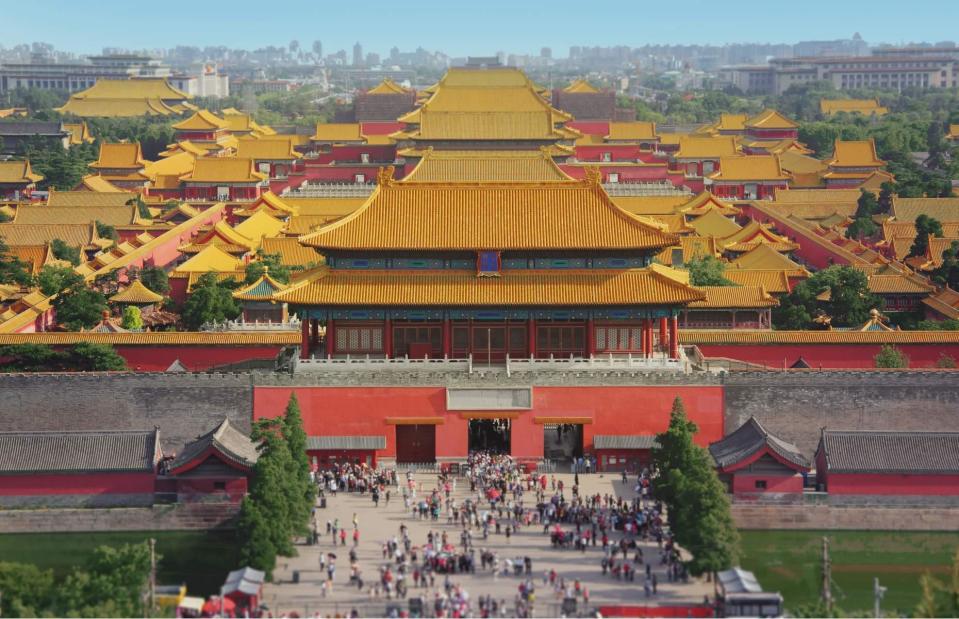
Sergii Rudiuk/Shutterstock
Gaining UNESCO World Heritage Site status in 1987, the Forbidden City is a far cry from the no-go zone it once was. But visitation remains limited to an extent, with a daily allowance of 80,000 people permitted to enter the complex. This cap was imposed in 2015; prior to that, up to 140,000 tourists came here every day. Entrance fees are cheaper during low season (November to March) to further discourage mass tourism.
Hagia Sophia, Istanbul, Turkey
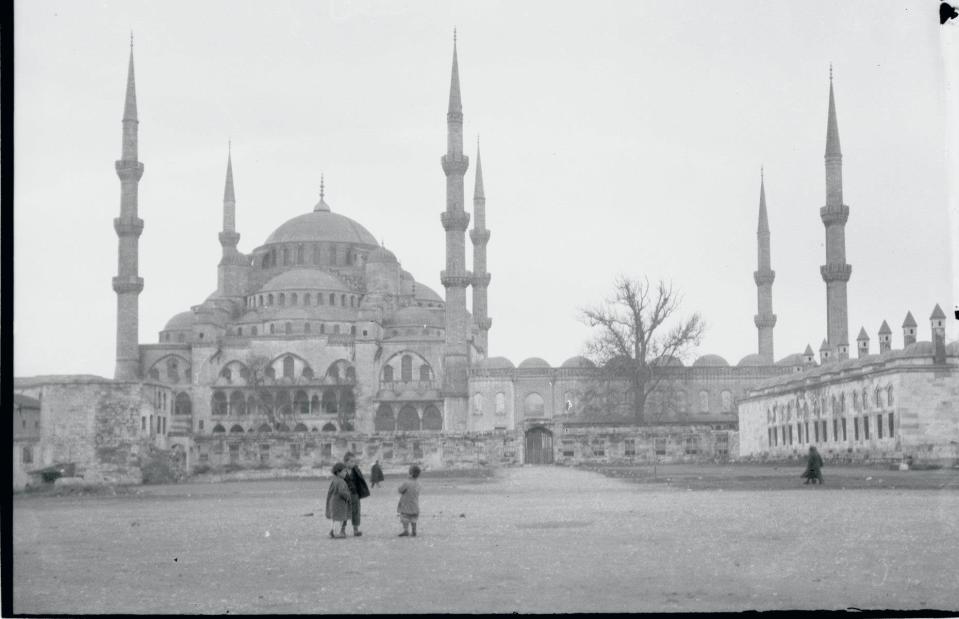
Bettmann/Getty Images
Istanbul was still widely referred to as Constantinople when this photo was taken in 1921. The city's name officially changed in 1930, eight years after the fall of the Ottoman Empire and seven years after the birth of the Republic of Turkey. Hagia Sophia oversaw it all: built as a Christian church in the 6th century AD under Byzantine ruler Justinian I, it was converted into a mosque after the Turks conquered Constantinople in 1453 before being secularised and repurposed as a museum in 1934.
Hagia Sophia, Istanbul, Turkey
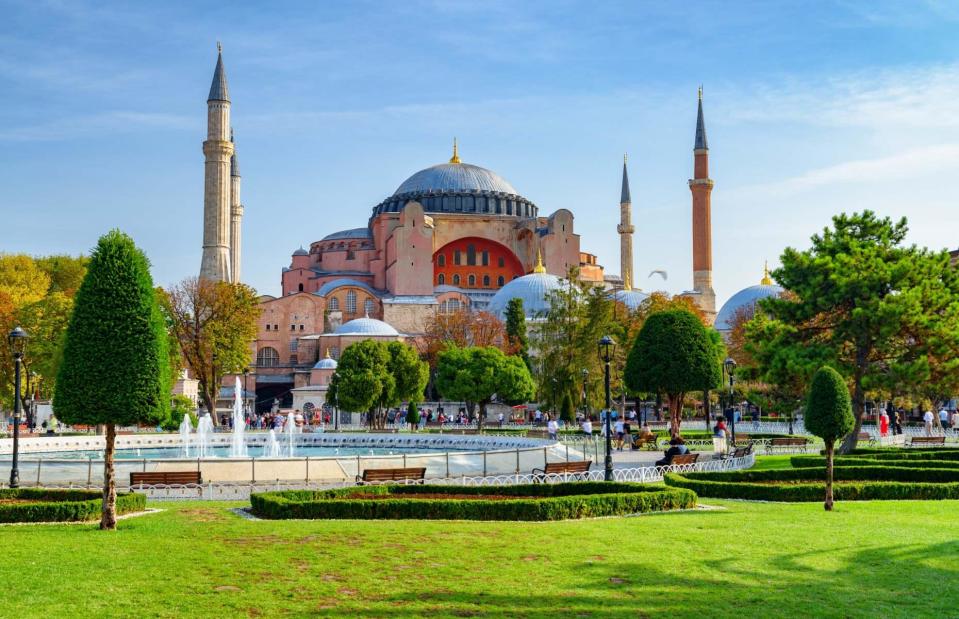
Efired/Shutterstock
Thirty-five years after being declared a UNESCO World Heritage Site, Hagia Sophia was reinstated as a mosque in 2020. It remains open to tourists outside of prayer hours and is recognised as Turkey's most important attraction, with more than three million annual visitors. Many of its original features can still be seen, including the so-called Emperor Door – which some believe is made from the wood of Noah's Ark.
Table Mountain, Cape Town, South Africa

Print Collector/Getty Images
Cape Town might have grown increasingly high-rise over the past few decades, but no man-made landmark can ever loom as large as the mighty Table Mountain. The flat-topped peak has been a designated protected area since 1939, when it was part of the Cape of Good Hope Nature Reserve; it was renamed Table Mountain National Park in 2004. In 2011, Table Mountain was voted one of the New Seven Natural Wonders of the World, along with the likes of Ha Long Bay in Vietnam and the Amazon River.
Table Mountain, Cape Town, South Africa
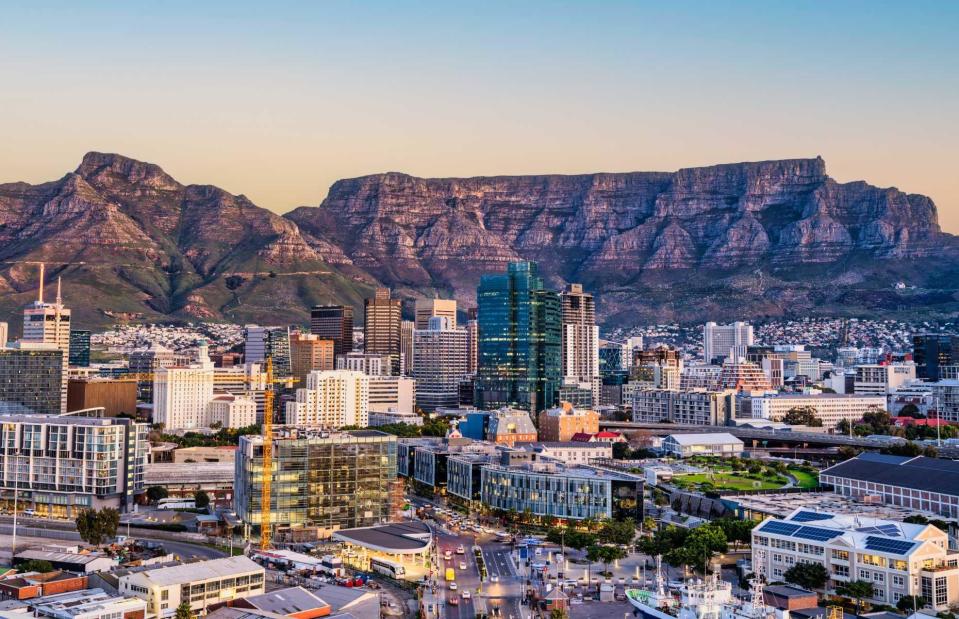
Arnold.Petersen/Shutterstock
Over 800,000 people visit the mountain each year, either by hiking to the top or taking the cable car. Founded in 1929 (five years after the previous photo was taken), the Table Mountain Aerial Cableway has since been upgraded three times; its very first set of gondolas (which transported King George VI and his young family, including Queen Elizabeth II) are on display at the Transport Museum in Johannesburg and at the Lower Cable Station in Cape Town, where one car has been given a new identity as an ice-cream kiosk.
Machu Picchu, near Cusco, Peru
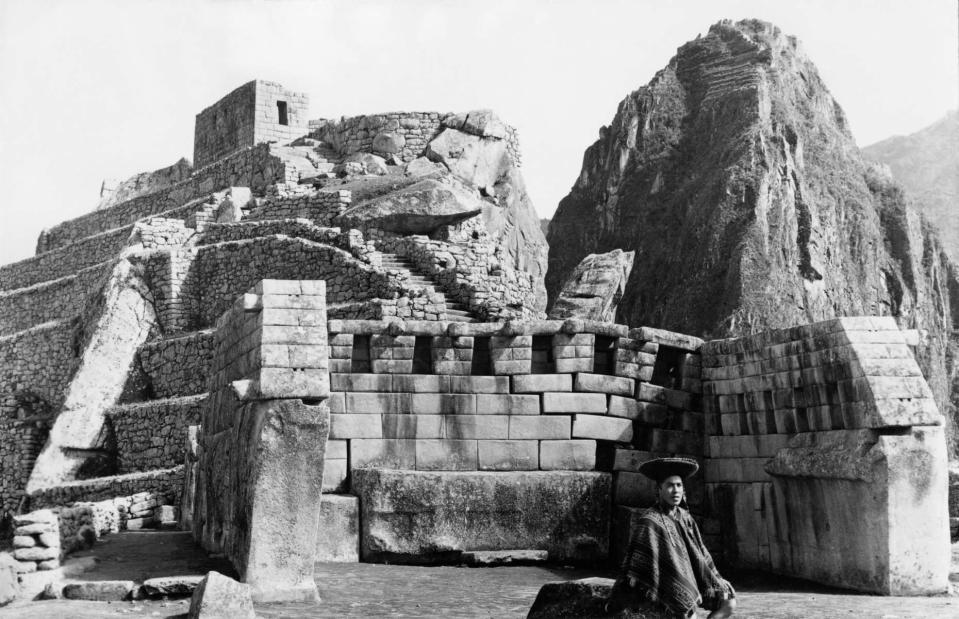
Glasshouse Images/Alamy
Once the pinnacle of the Inca Empire, the abandoned citadel of Machu Picchu lay relatively undiscovered for centuries after the ancient civilisation was all but wiped off the map by Spanish invaders in the 16th century. This postcard shows the ruins in 1920, nine years after American professor and explorer Hiram Bingham happened upon the forgotten Sacred Valley city on an expedition and shared its existence with the wider world. Ever since, the high-altitude settlement has had a love-hate relationship with tourism.
Machu Picchu, near Cusco, Peru

Rubens Alarcon/Alamy
A UNESCO World Heritage Site since 1983 and one of the New Seven Wonders of the World, Machu Picchu saw nearly one million visitors in 2022 alone, with the livelihoods of many local people heavily reliant on tourist spending. But years of overtourism have also caused ongoing concerns for the site’s conservation; in 2023, certain parts were cordoned off due to erosion. Also in 2023, direct flights between London and Lima were relaunched for the first time in four years, making it even easier for tourists to connect to Machu Picchu's gateway city, Cusco.
Neuschwanstein Castle, near Fussen, Germany

Kurt Hielscher/Public domain/Wikimedia Commons
Seen here in an aerial image from 1924, Schloss Neuschwanstein was built on the orders of the 'Fairy-Tale King' – Ludwig II of Bavaria – as a passion project inspired by his love of celebrated composer Richard Wagner. Construction of the sumptuous pile, nestled in the Bavarian Alps, was not completed in Ludwig's lifetime; it began in 1869 and continued until 1892. The king died in 1886 and only 14 rooms in the castle were ever finished.
Neuschwanstein Castle, near Fussen, Germany
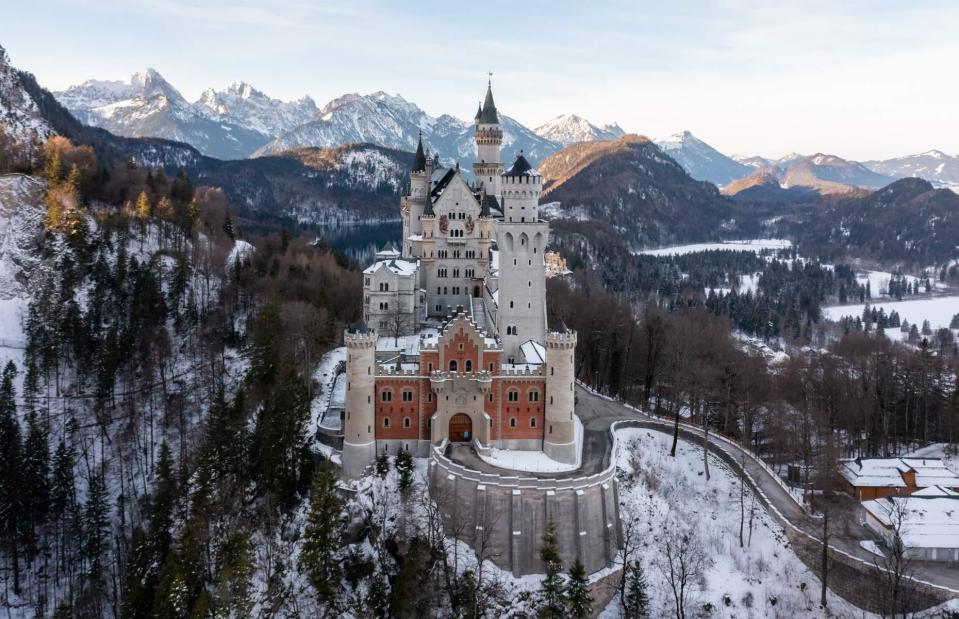
Wirestock Creators/Shutterstock
Within weeks of Ludwig’s passing, Neuschwanstein Castle was opened to the public in its unfinished state and never quite became a true realisation of the king’s creative vision; it stands today as a simplified interpretation of his dream, though still mightily impressive to the unknowing eye. Along with the king’s other regal residences, Neuschwanstein has been placed on UNESCO’s tentative list since 2015. More than 1.3 million people visit every year; a huge restoration effort is currently underway, expected to be completed later in 2024.
Angkor Wat, Siem Reap, Cambodia
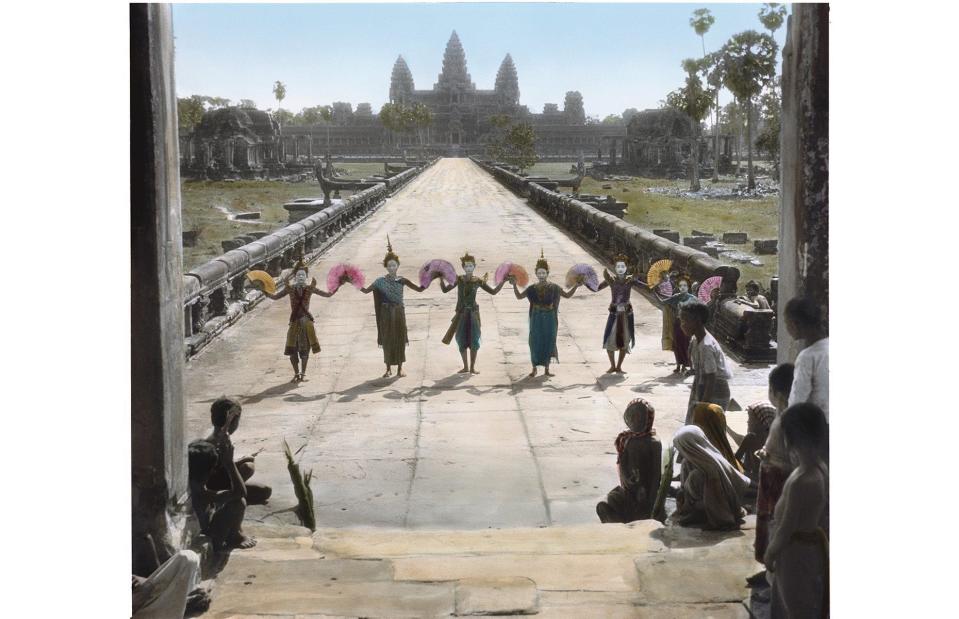
Archive Farms/Getty Images
Initially built as a Hindu temple complex dedicated to the god Vishnu in the first half of the 12th century, Angkor Wat had been converted to a place of Buddhist worship by the end of the 1100s. It remained operational as a temple into the 19th century and became known to Westerners around the 1840s, when French explorer Henri Mouhot described the complex as "grander than anything left to us by Greece or Rome". In this colourised photo from 1925, visitors to Angkor Wat are being welcomed to the site with a traditional dance performance.
Angkor Wat, Siem Reap, Cambodia

TANG CHHIN SOTHY/Getty Images
What we now know as Cambodia was ruled by the French for much of the 20th century and they were the first to realise Angkor Wat's potential as a tourist attraction. A commission to oversee its restoration was founded in the early 1900s, though efforts didn’t really break ground until the 1960s. The complex survived the devastating civil war of the 1970s to be designated by UNESCO in 1992, with representatives of France, Germany and India contributing to its restoration. After a stint on the World Heritage in Danger list, Angkor Wat was removed in 2004 and the site now attracts half a million annual visitors.
Sagrada Familia, Barcelona, Spain

Album/Alamy
Arguably the world’s most famous unfinished building, the Sagrada Familia has been under construction since 1882. Towering above the Catalan city, it is on track to become the world’s tallest church when it finally reaches completion in 2026. In this 1920 image, the cathedral's ribcage-like Nativity facade and apse are shown from what will become the inside. The facade, along with the Sagrada Familia’s crypt and various other works by Antoni Gaudi (the building’s former chief architect), was added to the UNESCO World Heritage Site register in 1984.
Sagrada Familia, Barcelona, Spain

JimmyM/Alamy
The Sagrada Familia’s expected completion date in 2026 survives Gaudi, who passed away in 1926, by 100 years. Formally opened to the public and consecrated for worship in 2010, the Sagrada Familia has been declared a minor basilica by Pope Benedict XVI and sees around four million visitors per year. September 2023 marked a major milestone in the landmark’s progress, when the third and fourth of its Evangelists towers were finished.
Grand Palace, Bangkok, Thailand

Associated Press/Alamy Stock Photo
Bangkok’s Grand Palace is a walled city within a city, built by King Rama I when he founded Bangkok as Thailand’s (then Siam) capital city back in 1782. It has been the official and ceremonial residence of the country’s kings ever since, and when this photo was taken in the early 1930s the majestic temples, palaces and carefully cultivated gardens were off-limits to the general public. All one could hope for was a glimpse of the gabled roofs as you went past in a boat.
Grand Palace, Bangkok, Thailand

Zoonar GmbH/Alamy Stock Photo
In 1932, Thailand became a constitutional monarchy following the Siamese Revolution. Around this time, the breathtaking royal complex, which had been gradually opened to the public since the early 20th century, allowed more visitors to wander among its brightly coloured buildings. Today, visitors can marvel at the golden spires, glittering mosaic and giant statues of Garuda guarding the doors, or worship at Thailand’s most sacred temple, Wat Phra Kaew, the Temple of the Emerald Buddha. It remains one of the country’s most popular tourist attractions, welcoming millions of visitors annually.
Circular Quay, Sydney, Australia

Hulton Archive/Getty Images
Sydney’s Circular Quay was created between 1837 and 1855 when convicts built sandstone walls to stabilise the new shoreline in Sydney Cove, reclaimed from mudflats. Initially known as ‘Semi-circular Quay’, it served as the major commercial port for ships making the long and treacherous passage to the young colony. By the 1870s, commercial shipping had moved to nearby Darling Harbour, and Circular Quay had transformed into a commuter hub for passenger ferries, trams and pedestrians.
Circular Quay, Sydney, Australia

David Angel/Alamy Stock Photo
In the decades since, Circular Quay has been bookended by two of Australia’s most famous icons, the Sydney Harbour Bridge, completed in 1932, and the Sydney Opera House, officially opened by Queen Elizabeth II on 20 October 1973. Circular Quay still serves as the city’s major ferry terminal but has become a popular harbourfront tourist attraction in its own right. It is also a focal point for Sydney's famous New Year’s Fireworks display and the increasingly popular Vivid Light Festival where both the Opera House and the Harbour Bridge are transformed by breathtaking light shows.
Copacabana, Brazil

Hulton Archive/Getty Images
Today Brazil’s Copacabana Beach is one of the country’s top balnearios (resort towns), drawing millions of visitors from around the world with its golden sands and gentle waters. But when this photo was taken it was still a quiet windswept coastal inlet, heavily wooded and home to small fishing communities and the odd fortress designed to warn off pirates. Back then it was known by its original Tupi moniker Sacopenapa, the way of the socos, named after the species of heron that soared on the winds here.
Copacabana, Brazil

Lazyllama/Alamy Stock Photo
By the turn of the 20th century, the area was developing rapidly and by 1921 the wooded forests had been replaced by hundreds of new homes and businesses laid out on neatly gridded streets. Roads were built to access the beach and a tram line was opened linking Copacabana to central Rio. Ritzy hotels and restaurants soon followed and Copacabana transformed into the international beach resort it remains today.
Senbon Torii, Kyoto, Japan

Fox Photos/Getty Images
Kyoto’s Fushimi Inari Taisha Shrine was built in 711 and is one of the oldest in Japan. It is home to Senbon Torii, or One Thousand Torii Gates, a path made up of up to 10,000 vermillion gates, each one donated by individuals and businesses hoping it will bring them prosperity. Their names can be seen inscribed in black on the sides of the gates. The torii seen here in this photo, taken around 1925, can be traced back to the Edo period (1603-1867).
Senbon Torii, Kyoto, Japan

YUICHI YAMAZAKI/AFP via Getty Images
While thousands of Japanese people still come to the shrine to pray for fruitful harvests and business success, millions more foreign visitors descend on Senbon Torii to get a shot for their Instagram. This photo taken in March 2024 gives some idea of the congestion caused, so much so that district officials are investigating ways to limit the number of visitors to Kyoto and curb bad tourist behaviour.


